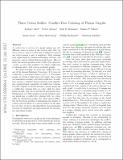| dc.contributor.author | Abel, Zachary | |
| dc.contributor.author | Alvarez, Victor | |
| dc.contributor.author | Demaine, Erik D. | |
| dc.contributor.author | Fekete, Sándor P. | |
| dc.contributor.author | Gour, Aman | |
| dc.contributor.author | Hesterberg, Adam | |
| dc.contributor.author | Keldenich, Phillip | |
| dc.contributor.author | Scheffer, Christian | |
| dc.date.accessioned | 2018-04-17T19:40:12Z | |
| dc.date.available | 2018-04-17T19:40:12Z | |
| dc.date.issued | 2017-01 | |
| dc.identifier.isbn | 978-1-61197-478-2 | |
| dc.identifier.uri | http://hdl.handle.net/1721.1/114769 | |
| dc.description.abstract | A conflict-free k-coloring of a graph assigns one of k different colors to some of the vertices such that, for every vertex v, there is a color that is assigned to exactly one vertex among v and v's neighbors. Such colorings have applications in wireless networking, robotics, and geometry, and are well-studied in graph theory. Here we study the natural problem of the conflict-free chromatic number x[subscript CF](G) (the smallest k for which conflict-free k-colorings exist), with a focus on planar graphs.
For general graphs, we prove the conflict-free variant of the famous Hadwiger Conjecture: If G does not contain K[subscript k+1] as a minor, then x[subscript CF](G) < k. For planar graphs, we obtain a tight worst-case bound: three colors are sometimes necessary and always sufficient. In addition, we give a complete characterization of the algorithmic/computational complexity of conflict-free coloring. It is NP-complete to decide whether a planar graph has a conflict-free coloring with one color, while for outer- planar graphs, this can be decided in polynomial time. Furthermore, it is NP-complete to decide whether a planar graph has a conflict-free coloring with two colors, while for outerplanar graphs, two colors always suffice. For the bicriteria problem of minimizing the number of colored vertices subject to a given bound k on the number of colors, we give a full algorithmic characterization in terms of complexity and approximation for outerplanar and planar graphs. | en_US |
| dc.description.sponsorship | Deutsche Forschungsgemeinschaft (FOR 1800) | en_US |
| dc.language.iso | en_US | |
| dc.relation.isversionof | http://dx.doi.org/10.1137/1.9781611974782.127 | en_US |
| dc.rights | Creative Commons Attribution-Noncommercial-Share Alike | en_US |
| dc.rights.uri | http://creativecommons.org/licenses/by-nc-sa/4.0/ | en_US |
| dc.source | arXiv | en_US |
| dc.title | Three Colors Suffice: Conflict-Free Coloring of Planar Graphs | en_US |
| dc.type | Article | en_US |
| dc.identifier.citation | Abel, Zachary, et al. "Three Colors Suffice: Conflict-Free Coloring of Planar Graphs." Proceedings of the Twenty-Eighth Annual ACM-SIAM Symposium on Discrete Algorithms, 16-19 January, 2017, Barcelona, Spain, Society for Industrial and Applied Mathematics, 2017, pp. 1951–63. | en_US |
| dc.contributor.department | Massachusetts Institute of Technology. Department of Mathematics | |
| dc.contributor.department | Massachusetts Institute of Technology. Computer Science and Artificial Intelligence Laboratory | |
| dc.relation.journal | Proceedings of the Twenty-Eighth Annual ACM-SIAM Symposium on Discrete Algorithms | en_US |
| dc.eprint.version | Author's final manuscript | en_US |
| dc.type.uri | http://purl.org/eprint/type/ConferencePaper | en_US |
| eprint.status | http://purl.org/eprint/status/NonPeerReviewed | en_US |
| dspace.orderedauthors | Abel, Zachary; Alvarez, Victor; Demaine, Erik D.; Fekete, Sándor P.; Gour, Aman; Hesterberg, Adam; Keldenich, Phillip; Scheffer, Christian | en_US |
| dspace.embargo.terms | N | en_US |
| mit.license | OPEN_ACCESS_POLICY | en_US |
